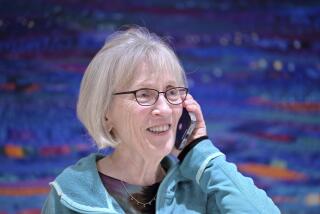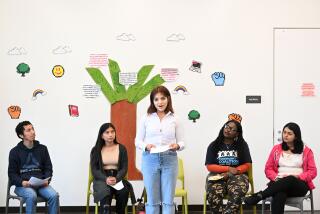Conquering the ‘Bag Lady Nightmare’
- Share via
One of every two working women suffers from the “bag lady nightmare”--a fear that at some time in her life she will become destitute--according to a national survey conducted by Working Woman magazine.
What is remarkable about the figure is that the women who answered the survey--4,000 Working Woman readers--were primarily college-educated women who held managerial jobs and had household mean incomes of $59,910.
Or perhaps it is not so remarkable. Bonnie Sivard, a personal finance specialist who wrote the article about the survey published in the magazine’s November issue, pointed out that the vision of poverty around the corner “is not a neurotic hang-up, unfortunately, but a bona-fide fear.” One in five American women over 65 does live in poverty.
Teen-age girls do not relate to being 65. They don’t even relate to being 30, said Mindy Bingham, director of the Santa Barbara Girls Club and originator of an innovative program to help teens plan a future that will not include poverty.
As director of the Girls Club for 12 years, Bingham said one of the greatest problems she saw was that young girls have no awareness of one of the most striking realities of our time: that they are likely to have to support themselves and perhaps a family at some time in their lives.
“The women’s movement has not filtered down below the age of 18,” Bingham said. The majority of teen-age girls believes that they will grow up, marry and stay home with their children and that their husbands will take care of them. The statistics belie that view: almost half of all women with children under a year old work outside their homes, and two-thirds of employed women have no choice--they work because of economic necessity. Since 1965, the number of female-headed families living in poverty has increased by 70%.
The Girls Club began to introduce programs such as visits to college campuses. “We took girls who had never seen a college, who had no idea that they had these choices,” Bingham said.
The Fourth R
However, by the late 1970s, “it became obvious that we had to do more than surface things to change girls’ attitudes,” she said. The result was a class in Santa Barbara high schools and a workbook called “Choices.” Bingham calls the program the “fourth R”--reality.
The book and the program were so successful that more than 100,000 copies have been sold in the U.S. and overseas, with proceeds going to the Santa Barbara Girls Club. The class has been introduced in high schools all over the country--at one San Diego high school it is required. And the program has recently been expanded to include teen-age boys who use a companion book, also written by Bingham and colleagues, called “Challenges.”
The book and class require teen-agers to realistically plan their futures. It starts by asking each student to project her life style when she is 28 years old. (“We tried 30, and they didn’t relate to that age,” Bingham said. For some reason, teens were able to imagine being 28.) The students envision all aspects of their lives at 28--from marriage and children to the type of housing and car they want and where they’d want to go on vacations.
The plan for family is the same for almost every girl who has been through the program, Bingham said: At the age of 28, almost all girls say they hope to be married and have two pre-school children, a boy and a girl, the boy born first. Youngsters of all socioeconomic levels say they intend to own a house. “Kids are so programmed--scripted very early--that this is what their life will be like,” Bingham said.
After determining what they want, using newspaper advertising and other information, the students plan in detail how much their desired life styles will cost: house payments, car payments, utilities, insurance, food, clothing, entertainment, vacations, etc. By the time they get to entertainment, “they begin to get nervous,” Bingham said. “They see the figures (monthly cost for what they believe they need and desire) adding up.” Bingham, who said she has her own 10-year-old daughter write the checks for all the household bills each month, said most teens have no idea what things like utilities or clothing cost, even though teen-age girls spend most of their discretionary income on clothes.
The last step, after calculating the cost of the life style they envision for themselves, is to have the students use the classified ads to find jobs that they believe they could train for and hold by the age of 28 that would pay the gross salary needed to support the chosen life.
A Decision to Make
“That’s a real eye opener,” Bingham said. “We see girls who’d said they want to be secretaries asking, ‘What’s an MBA?’ Girls who wanted to be nurses start talking about medical school. One girl who wanted to be a TV weather girl realized she’d have to own the station.” The youngsters realize they have a decision to make: Would they be willing to lower their life-style expectations or should they consider and aim for higher paying careers. Most of the young women who have gone through the “Choices” exercise choose to raise their career ambitions.
The program is given for 14-year-old ninth-graders because that is the age when teens can effectively raise their ambitions as they make decisions about high school courses. “We stress math and science,” said Bingham, not necessarily to push students into these careers but to keep their options open. “Math is known as the critical filter--it filters people out from the higher paying careers. Choices are limited for students who don’t take the algebra-geometry and higher high school math sequence.”
The economic focus of the “Choices” program appeals to teens. “If there is one thing teens relate to, it’s money,” Bingham said. And, unlike many career planning programs for young students, the “Choices” program gives a concrete answer to students who ask, “Why do I need to take these classes? Why do I need to have a career?” she said.
Connie LaFace-Olson, director of the Los Angeles Unified School District’s Commission for Sex Equity, said that she had successfully used the book in 15 Los Angeles schools before coming to her present position. The book is on the district’s list of supplemental textbooks for career- and life-planning classes. “We like to believe kids of the ‘80s are different from kids of the ‘60s or ‘70s, but they’re very traditional,” she said. “Many girls still believe Prince Charming is going to ride up in his white Porsche and provide a beautiful house and wonderful kids. For the majority, that’s not the way life’s going to be. This book gently pushes aside those fairy-tale illusions.”
LaFace-Olson said the classes in Los Angeles are coeducational and used to help students of both sexes see that men and women will not live in the same roles as their grandparents. It helps boys see how women’s roles are changing and that their roles have to change too, that the “superwoman” who has a career and does all the traditional women’s work can’t continue forever, she said.
The book for boys, “Challenges,” was recently added to the Girls Club program. It is the same as “Choices” for girls in many respects, teaching young boys the same financial realities as to what the lives they hope for will cost and what kind of careers they must plan to pay for it.
Copies of “Choices” or “Challenges” are $14.50 and may be ordered from Advocacy Press, Box 236 Dept. G., Santa Barbara 93102. Proceeds benefit the Girls Club of Santa Barbara.


